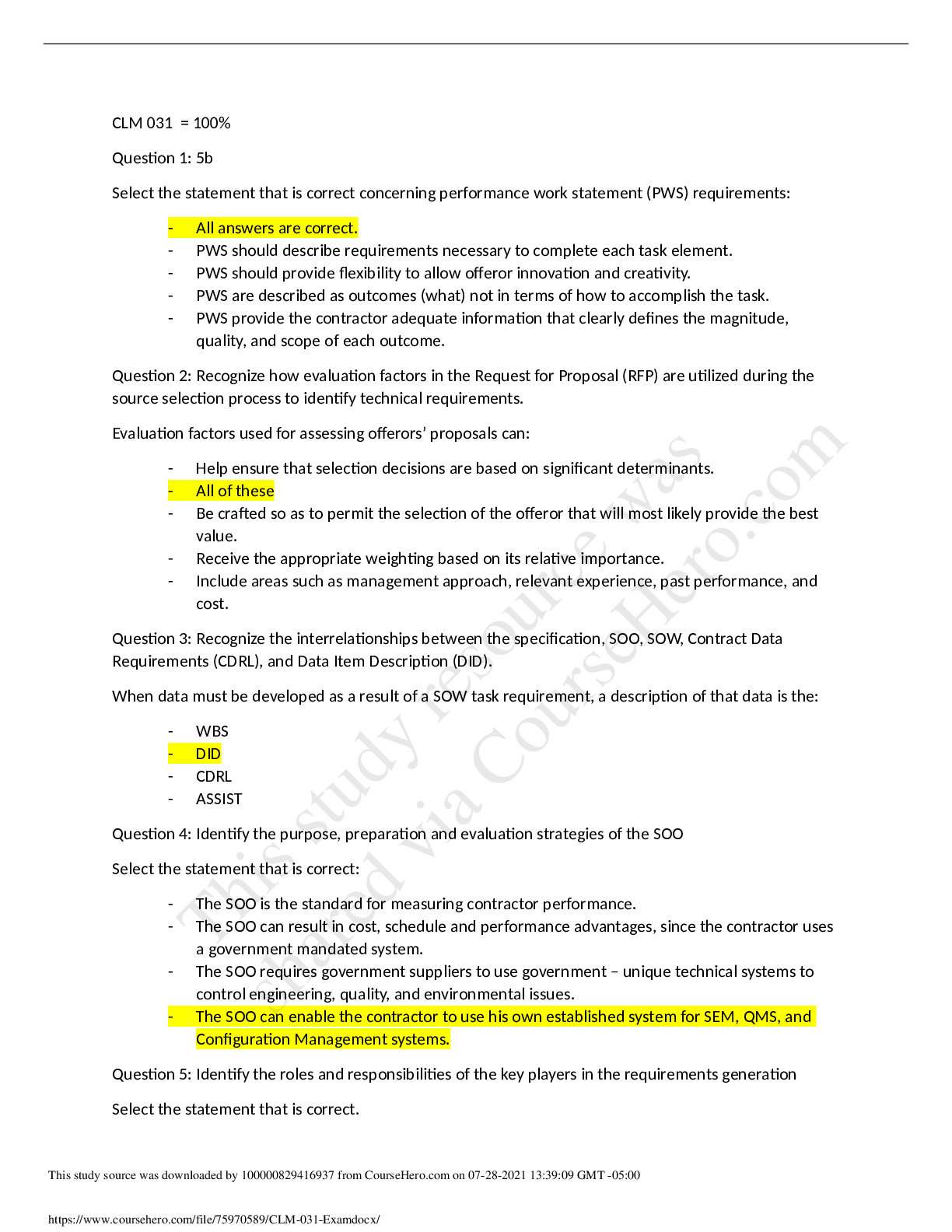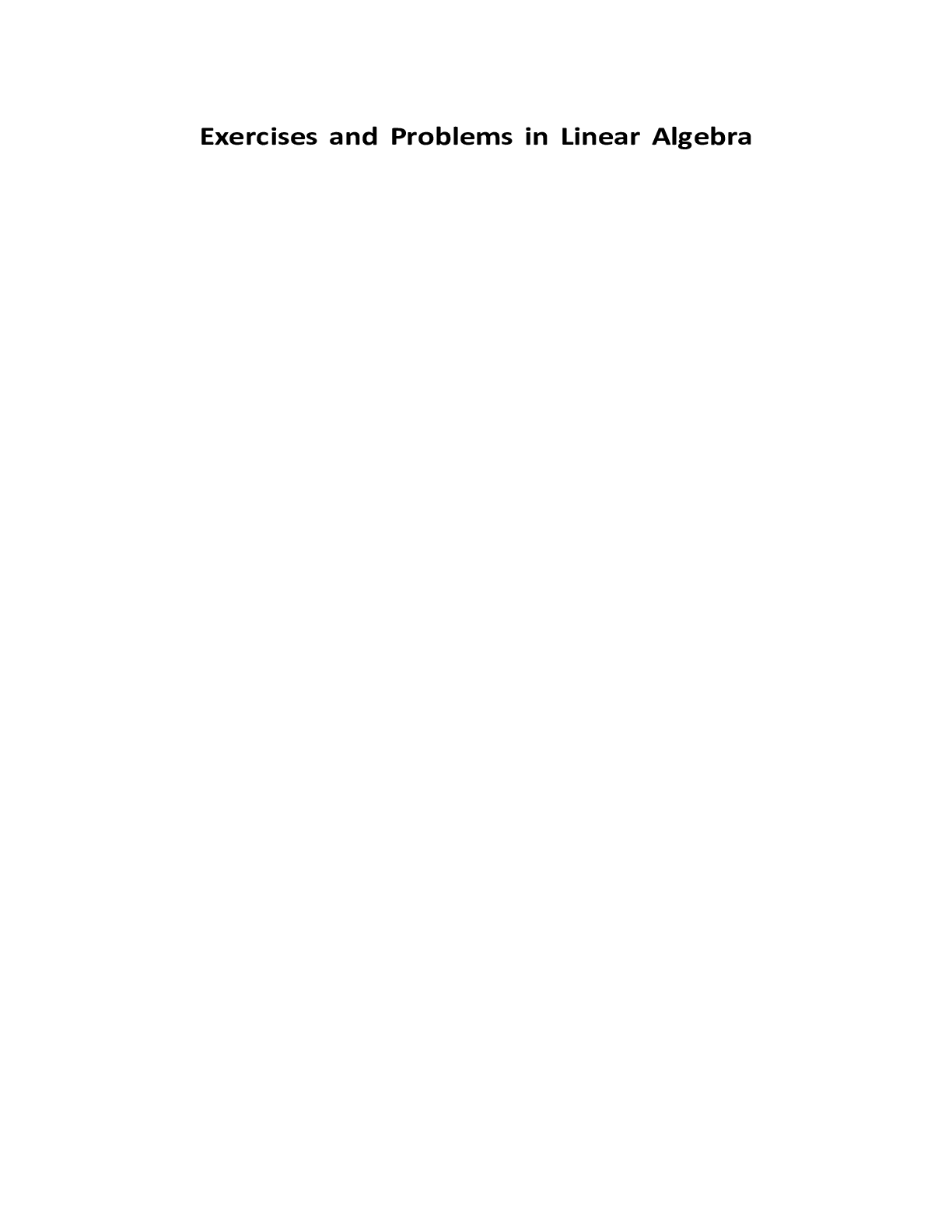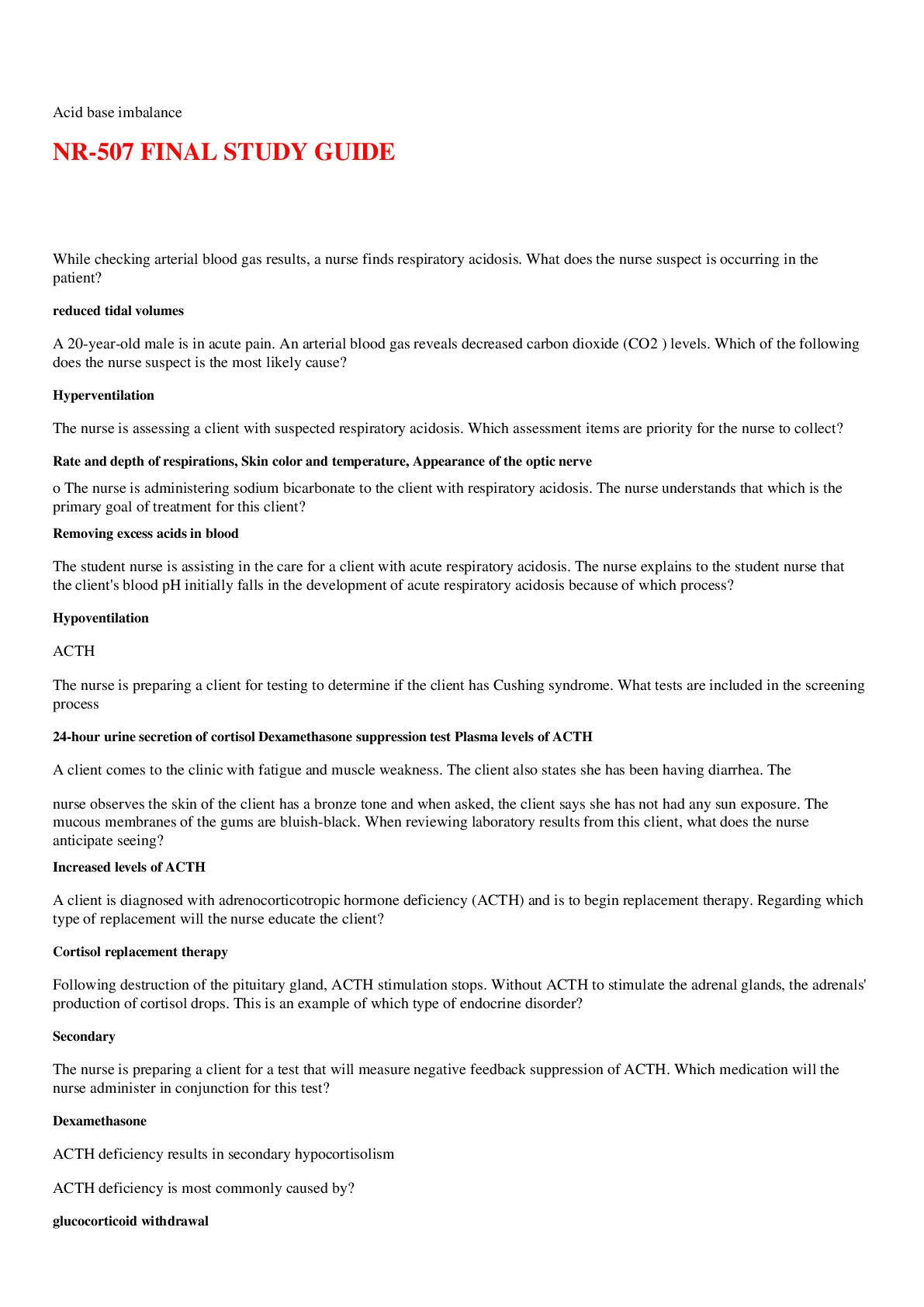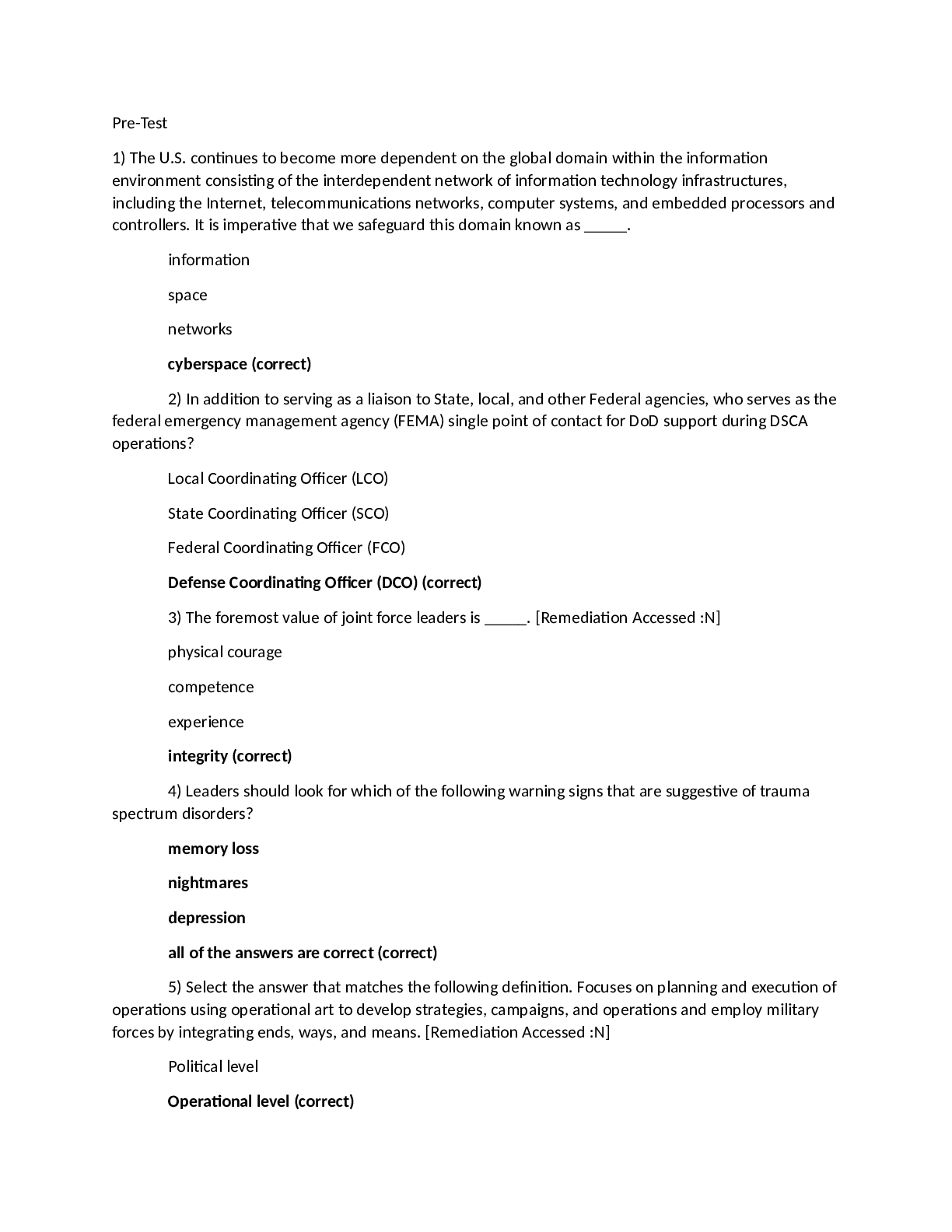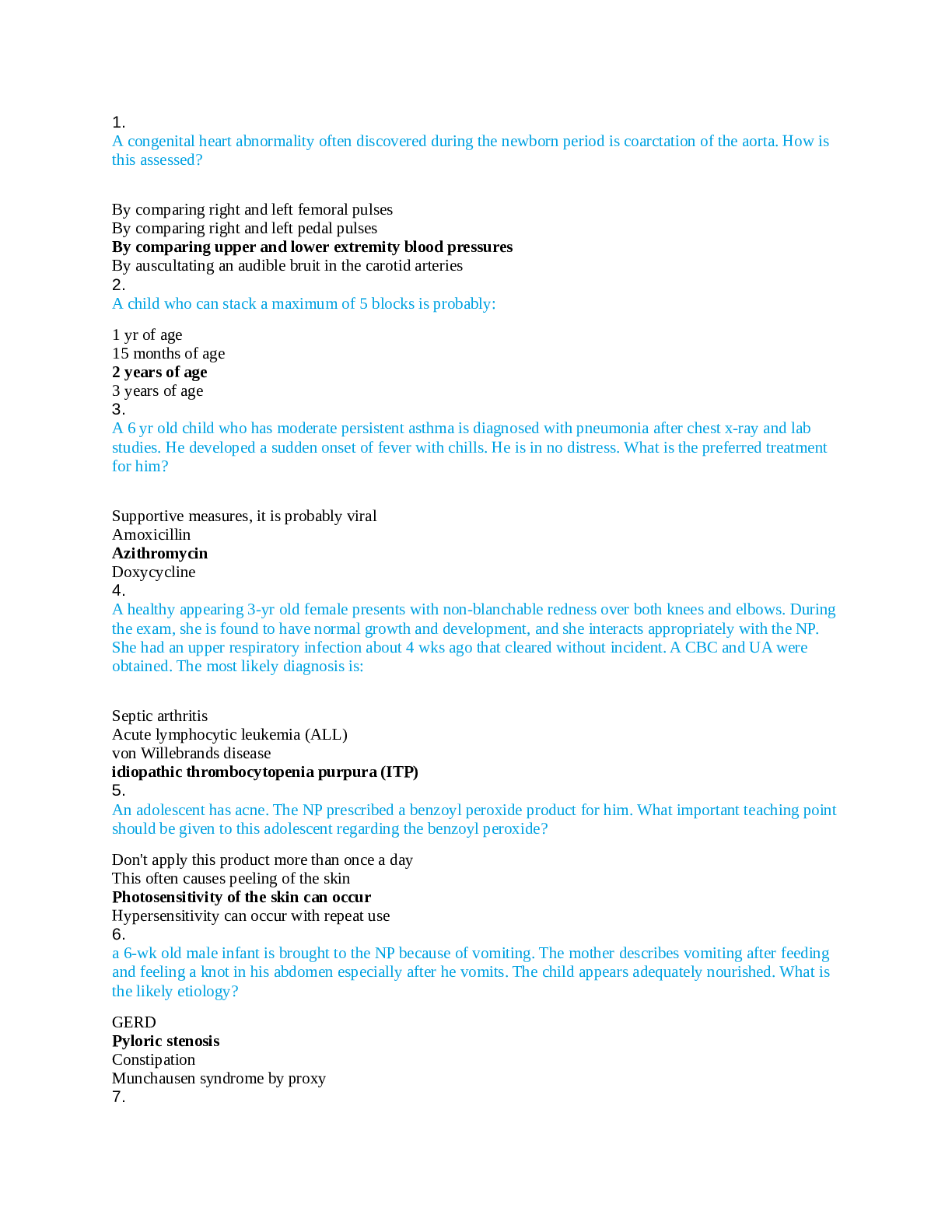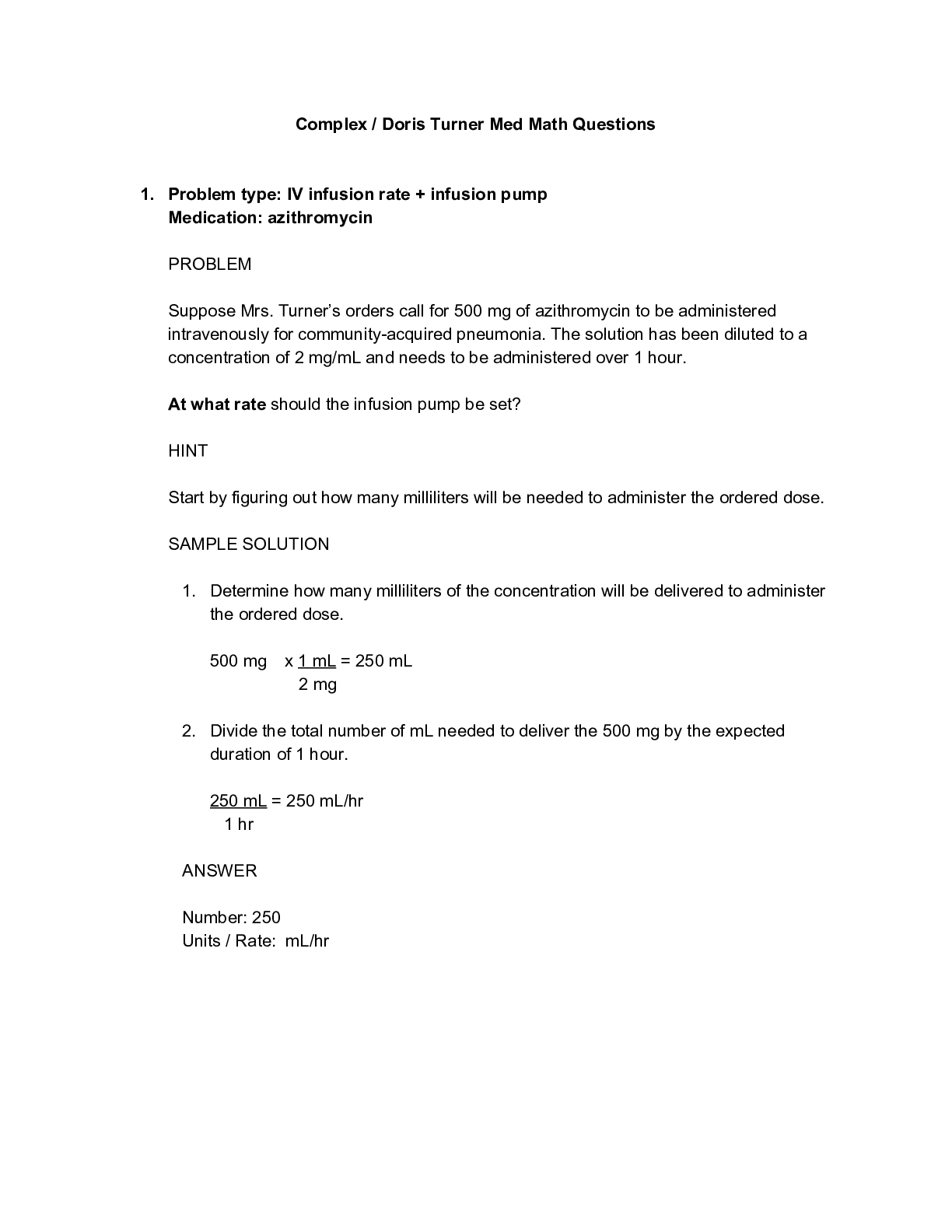Anatomy and Physiology - A&P 2 > QUESTIONS & ANSWERS > BIO202_MH_V3: Cardiovascular System: Blood Vessels and Circulation (GRADED A) PERFECT REVISION TOOL (All)
BIO202_MH_V3: Cardiovascular System: Blood Vessels and Circulation (GRADED A) PERFECT REVISION TOOL
Document Content and Description Below
Page path BIO202_MH_V3 Topic 3: Cardiovascular System: Blood Vessels and Circulation Started on Thursday, October 21, 2021, 1:22 AM State Finished Completed on Thursday, October 21, 2021,... 1:45 AM Time taken 23 mins 8 secs Grade 40.00 out of 40.00 (100%) Question 1 Correct 2.00 points out of 2.00 Flag question Question text Venous drainage from the posterior thoracic wall enters the superior vena cava via the ______ vein. Select one: a. subclavian b. internal thoracic c. accessory hemiazygos d. hemiazygos e. azygos Question 2 Correct 2.00 points out of 2.00 Flag question Question text Select the description below that describes pulmonary circulation. Select one: a. System of blood vessels that carries blood from the heart to the lungs and back to the right atrium of the heart. b. System of blood vessels that a carries blood from the heart to the rest of the body. c. Finely dissected blood vessels that allow for the exchange of nutrients in the tissues. d. System of blood vessels that carries blood from the heart to the lungs and back to the left atrium of the heart. Question 3 Correct 2.00 points out of 2.00 Flag question Question text The hepatic portal vein is formed by the union of the splenic vein and the Select one: a. superior mesenteric vein. b. inferior mesenteric vein. c. hepatic vein. d. renal vein. e. gastric vein. Question 4 Correct 2.00 points out of 2.00 Flag question Question text The three major arteries of the upper limb that form a continuum are the Select one: a. brachial, radial, and ulnar arteries. b. brachial, axillary, and radial arteries. c. subclavian, axillary, and radial arteries. d. subclavian, axillary, and brachial arteries. e. cephalic, basilic, and brachial arteries Question 5 Correct 2.00 points out of 2.00 Flag question Question text All of the following are functions of the circulatory system, except Select one: a. carries blood. b. regulates blood pressure. c. transports nutrients. d. directs blood flow to tissues. e. excretes wastes. Question 6 Correct 2.00 points out of 2.00 Flag question Question text Blood flow into the deep and superficial palmar arches originates from the ______ and ____ arteries. Select one: a. humeral circumflex; deep brachial b. superficial palmar arch; digital c. brachial; subclavian d. axillary; subclavian e. radial; ulnar Question 7 Correct 2.00 points out of 2.00 Flag question Question text According to Poiseuille's law, a small decrease in the diameter of a vessel will Select one: a. dramatically decrease blood flow. b. slightly decrease blood flow. c. not affect blood flow. d. slightly increase blood flow. e. dramatically increase blood flow. Question 8 Correct 2.00 points out of 2.00 Flag question Question text Which of the following would occur as a result of increased renin release by the kidneys? Select one: a. an increase in vasodilator secretion b. an increase in urine output c. an increase in blood volume d. a decrease in aldosterone e. a decrease in blood pressure Question 9 Correct 2.00 points out of 2.00 Flag question Question text Arteries can constrict or dilate as needed because of the smooth muscle found in the Select one: a. tunica intima. b. tunica media. c. tunica adventitia. d. tunica externa. e. tunica interna. Question 10 Correct 2.00 points out of 2.00 Flag question Question text Which of the following functions is associated with vessels that carry blood directly from arterioles to veins without passing through capillaries? Select one: a. thermoregulation b. nutrient supply to tissues c. removal of metabolic waste products from tissues d. oxygen supply to tissues e. pH regulation Question 11 Correct 2.00 points out of 2.00 Flag question Question text Which kind of vessel provides a bypass for a capillary bed? Select one: a. sinusoid b. portal vein c. thoroughfare channel d. vasa vasorum e. metarteriole Question 12 Correct 2.00 points out of 2.00 Flag question Question text What are vasa vasorum? Select one: a. Blood vessels that connect primary and secondary capillary networks. b. Structures within veins that keep blood flowing in one direction. c. Connective tissue that surrounds large vessels. d. Nerve plexuses surrounding the blood vessel. e. Blood vessels that nourish the tunica adventitia and tunica media. Question 13 Correct 2.00 points out of 2.00 Flag question Question text Which of the following enhances the exchange between capillary walls and the interstitial spaces? Select one: a. the thinness of the capillary wall b. minimal branching in the capillary bed c. increased blood velocity through the capillaries d. the high pressure in the interstitial spaces e. the stratification of the capillary wall Question 14 Correct 2.00 points out of 2.00 Flag question Question text In capillary exchange, which of the following statements is true? Select one: a. Most fluid that leaves the arterial end of a capillary reenters the venous end of a capillary. b. Interstitial fluid normally has a higher osmotic pressure than plasma. c. Constriction of the precapillary sphincter will increase blood pressure in the capillary. d. Interstitial protein concentration is normally higher than plasma protein concentration. e. Most fluid that leaves the arterial end of a capillary enters the lymphatic system. Question 15 Correct 2.00 points out of 2.00 Flag question Question text What is the order of the blood vessels that a red blood cell would pass through as the blood leaves the heart, travels to a tissue, and then returns to the heart? Select one: a. arteriole, artery, capillary, vein, venule b. capillary, arteriole, artery, vein, venule c. artery, arteriole, capillary, venule, vein d. vein, capillary, artery, arteriole, venule e. artery, venule, capillary, arteriole, vein Question 16 Correct 2.00 points out of 2.00 Flag question Question text Which of the following is NOT a pericapillary cell found in capillaries? Select one: a. macrophages b. neurons c. undifferentiated smooth muscle cells d. fibroblasts Question 17 Correct 2.00 points out of 2.00 Flag question Question text Arteriosclerosis results in decreased compliance, which in turn causes the pulse pressure to Select one: a. increase. b. decrease. c. increase, then decrease. d. decrease, then increase. e. remain the same. Question 18 Correct 2.00 points out of 2.00 Flag question Question text Art is 75. He has advanced arteriosclerosis. He is suffering from a number of manifestations, which are consistent with his arteriosclerosis. Over the past several years he has developed hypertension and he is beginning to show signs of renal failure. Which of the following are consistent with his condition? Select one: a. increased resistance to blood flow b. increased renin secretion from the kidneys c. increased aldosterone secretion from the adrenal cortex d. increased angiotensinogen formation e. All of these choices is correct. Question 19 Correct 2.00 points out of 2.00 Flag question Question text In response to circulatory shock, Select one: a. the body decreases ADH secretion. b. the renin-angiotensin mechanism is activated. c. atrial natriuretic factor is released. d. the vasomotor center is inhibited. e. the baroreceptors and chemoreceptors are inactivated. Question 20 Correct 2.00 points out of 2.00 Flag question Question text Case study: Dale Fremore was back home after spending the day at a picnic where he ate some "spoiled" potato salad. He developed severe abdominal pain and cramps, vomiting, and diarrhea. After about ten to twelve episodes of water diarrhea, Mr. Fremore became so pale and weak he could hardly walk. His wife took him to the hospital where he was diagnosed with severe dehydration (decreased plasma volume). Mr. Fremore was suffering from shock. The body has several mechanisms that can come into play to try to maintain blood pressure and blood flow when a person goes into shock. Urine output usually decreases when a person is in shock. This is the result of Select one: a. decreased ADH secretion. b. increased renin secretion. c. increased secretion of atrial natriuretic factor. d. decreased vasoconstriction due to the stress relaxation response. e. decreased aldosterone secretio [Show More]
Last updated: 2 years ago
Preview 1 out of 11 pages
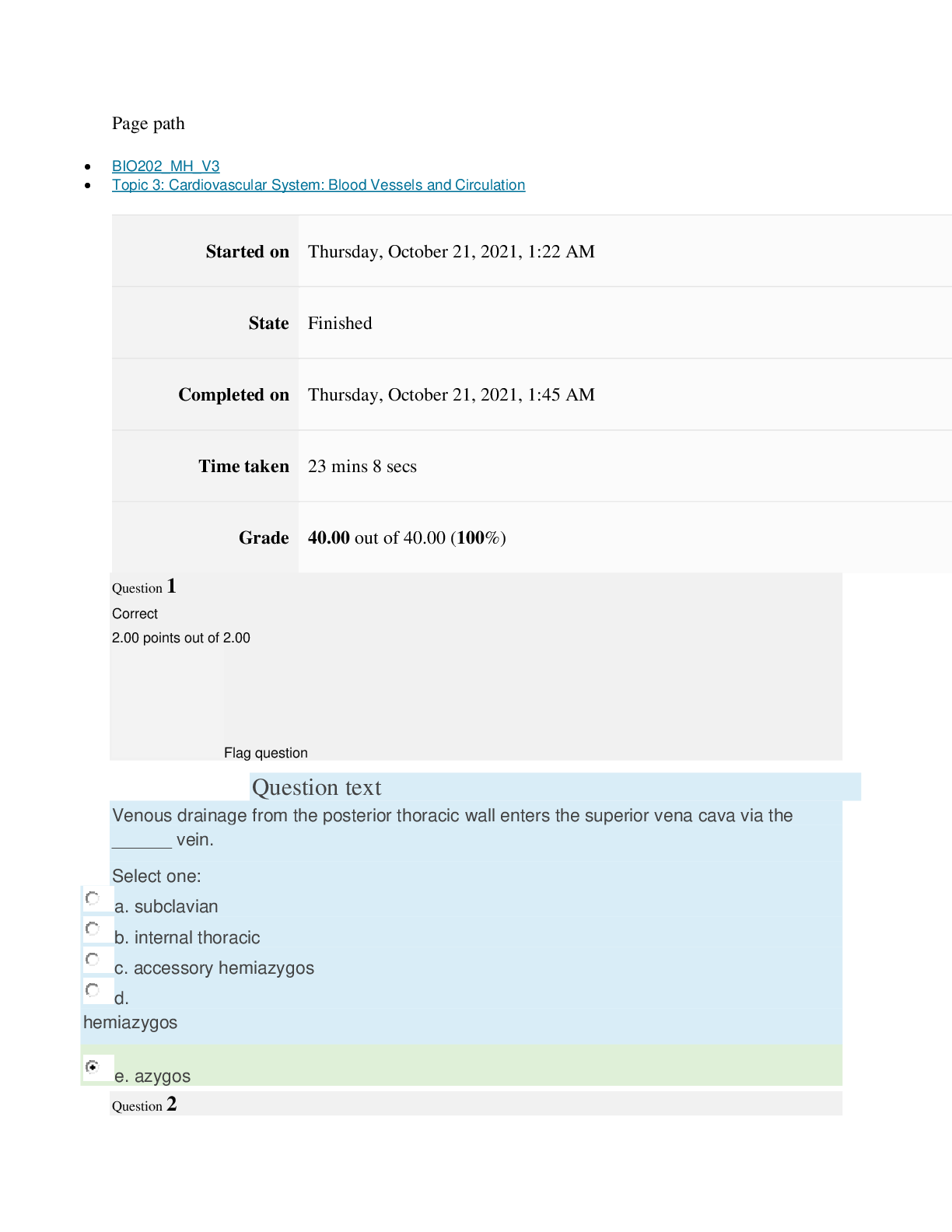
Buy this document to get the full access instantly
Instant Download Access after purchase
Buy NowInstant download
We Accept:

Reviews( 0 )
$8.00
Can't find what you want? Try our AI powered Search
Document information
Connected school, study & course
About the document
Uploaded On
Dec 04, 2022
Number of pages
11
Written in
Additional information
This document has been written for:
Uploaded
Dec 04, 2022
Downloads
0
Views
180



